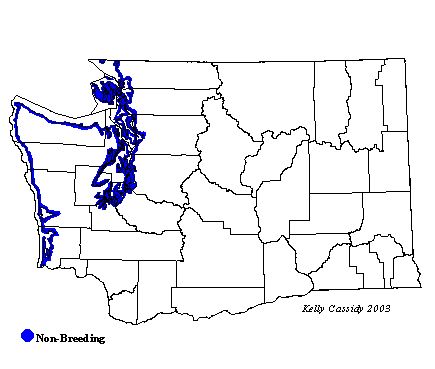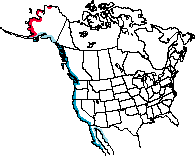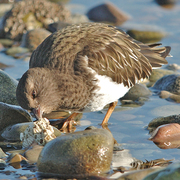Black Turnstone
General Description
The Black Turnstone is a compact, short-billed bird found on rocky shores. All plumages are mostly black with white bellies. Their bellies and underwings are white, and their heads and breasts are black. In flight, they show white on the back, wings, and base of the tail. In breeding plumage, the Black Turnstone has a white mustache and some white on the breast. Its legs are orange-brown and can be quite bright, although not as bright as those of the Ruddy Turnstone. Males and females appear similar, but males are brighter with more contrast in color on the head. Their long, black wing coverts contrast with their white sides.
Habitat
A coastal species at all times of the year, Black Turnstones nest in the wet tundra of coastal Alaska, often near estuaries or lagoons. They migrate and winter along the rocky shorelines of the Pacific Coast. They are most often found foraging on rocky shores, jetties, and islets. They also forage on top of kelp beds.
Behavior
Black Turnstones are usually found in small flocks, but they may number 100 or more.
The Black Turnstone moves steadily and slowly over rocks, looking for prey to pry off with its strong bill, thus its name. On beaches it turns over rocks and shells in search of food, although not as often as the related Ruddy Turnstone.
Diet
Limpets and acorn barnacles are the most important food items on the wintering grounds of the Black Turnstone. During the breeding season, they eat many insects as well as some berries and seeds.
Nesting
Black Turnstones return to the same nest and pair with the same mate year after year. They nest on the ground, among sedges or grasses close to water. The nest is sometimes out in the open, sometimes hidden by tall vegetation. Both parents help make the shallow scrape lined with grass. Both help incubate the four eggs for 22-24 days. The young leave the nest shortly after hatching and find their own food. Both parents tend the young, but the female leaves about two weeks post-hatching, and the male cares for the young until they are independent. They begin to make short flights at 23 days, and have mastered sustained flight by 28-30 days.
Migration Status
Migrants follow the coastline closely in spring on their way back to coastal breeding grounds in Alaska. In the fall, some birds cut across the Gulf of Alaska to shorten their trip south. They winter from the southern coast of Alaska down the Pacific to Mexico.
Conservation Status
The Canadian Wildlife Service estimates the population at 80,000 birds. Christmas Bird Count data suggest that there has been a decline in recent years. Black Turnstones are listed as a species of special concern on the Partners in Flight watch list.
When and Where to Find in Washington
Black Turnstones are common throughout the winter on rocky shores along the outer coast of Washington and in Puget Sound south to Seattle. They start leaving for the breeding grounds in mid-May and are rare in Washington by the first half of June. A few birds return in late June, more arrive in July, and they are once again common by mid-July. Juveniles follow in August. There are a few scattered records inland, but the Black Turnstone is primarily a bird of the coast. Penn Cove on Whidbey Island (Island County) is an excellent place to see them, as are Alki Beach in West Seattle (King County) and Drayton Harbor (Whatcom County).
 Abundance
Abundance
| Ecoregion | Jan | Feb | Mar | Apr | May | Jun | Jul | Aug | Sep | Oct | Nov | Dec |
|---|---|---|---|---|---|---|---|---|---|---|---|---|
| Oceanic | ||||||||||||
| Pacific Northwest Coast | C | C | C | C | U | U | C | C | C | C | C | |
| Puget Trough | C | C | C | C | U | U | U | F | C | C | C | |
| North Cascades | ||||||||||||
| West Cascades | ||||||||||||
| East Cascades | ||||||||||||
| Okanogan | ||||||||||||
| Canadian Rockies | ||||||||||||
| Blue Mountains | ||||||||||||
| Columbia Plateau |
Washington Range Map

North American Range Map


Family Members
 Spotted SandpiperActitis macularius
Spotted SandpiperActitis macularius Solitary SandpiperTringa solitaria
Solitary SandpiperTringa solitaria Gray-tailed TattlerTringa brevipes
Gray-tailed TattlerTringa brevipes Wandering TattlerTringa incana
Wandering TattlerTringa incana Greater YellowlegsTringa melanoleuca
Greater YellowlegsTringa melanoleuca WilletTringa semipalmata
WilletTringa semipalmata Lesser YellowlegsTringa flavipes
Lesser YellowlegsTringa flavipes Upland SandpiperBartramia longicauda
Upland SandpiperBartramia longicauda Little CurlewNumenius minutus
Little CurlewNumenius minutus WhimbrelNumenius phaeopus
WhimbrelNumenius phaeopus Bristle-thighed CurlewNumenius tahitiensis
Bristle-thighed CurlewNumenius tahitiensis Long-billed CurlewNumenius americanus
Long-billed CurlewNumenius americanus Hudsonian GodwitLimosa haemastica
Hudsonian GodwitLimosa haemastica Bar-tailed GodwitLimosa lapponica
Bar-tailed GodwitLimosa lapponica Marbled GodwitLimosa fedoa
Marbled GodwitLimosa fedoa Ruddy TurnstoneArenaria interpres
Ruddy TurnstoneArenaria interpres Black TurnstoneArenaria melanocephala
Black TurnstoneArenaria melanocephala SurfbirdAphriza virgata
SurfbirdAphriza virgata Great KnotCalidris tenuirostris
Great KnotCalidris tenuirostris Red KnotCalidris canutus
Red KnotCalidris canutus SanderlingCalidris alba
SanderlingCalidris alba Semipalmated SandpiperCalidris pusilla
Semipalmated SandpiperCalidris pusilla Western SandpiperCalidris mauri
Western SandpiperCalidris mauri Red-necked StintCalidris ruficollis
Red-necked StintCalidris ruficollis Little StintCalidris minuta
Little StintCalidris minuta Temminck's StintCalidris temminckii
Temminck's StintCalidris temminckii Least SandpiperCalidris minutilla
Least SandpiperCalidris minutilla White-rumped SandpiperCalidris fuscicollis
White-rumped SandpiperCalidris fuscicollis Baird's SandpiperCalidris bairdii
Baird's SandpiperCalidris bairdii Pectoral SandpiperCalidris melanotos
Pectoral SandpiperCalidris melanotos Sharp-tailed SandpiperCalidris acuminata
Sharp-tailed SandpiperCalidris acuminata Rock SandpiperCalidris ptilocnemis
Rock SandpiperCalidris ptilocnemis DunlinCalidris alpina
DunlinCalidris alpina Curlew SandpiperCalidris ferruginea
Curlew SandpiperCalidris ferruginea Stilt SandpiperCalidris himantopus
Stilt SandpiperCalidris himantopus Buff-breasted SandpiperTryngites subruficollis
Buff-breasted SandpiperTryngites subruficollis RuffPhilomachus pugnax
RuffPhilomachus pugnax Short-billed DowitcherLimnodromus griseus
Short-billed DowitcherLimnodromus griseus Long-billed DowitcherLimnodromus scolopaceus
Long-billed DowitcherLimnodromus scolopaceus Jack SnipeLymnocryptes minimus
Jack SnipeLymnocryptes minimus Wilson's SnipeGallinago delicata
Wilson's SnipeGallinago delicata Wilson's PhalaropePhalaropus tricolor
Wilson's PhalaropePhalaropus tricolor Red-necked PhalaropePhalaropus lobatus
Red-necked PhalaropePhalaropus lobatus Red PhalaropePhalaropus fulicarius
Red PhalaropePhalaropus fulicarius

